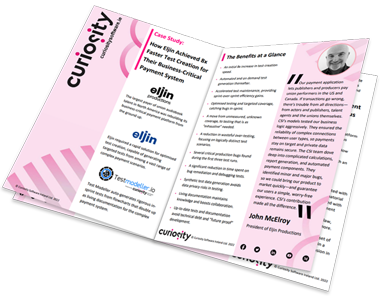 UI Test Automation
UI Test Automation
Eliminate scripting bottlenecks with in-sprint testing.
Exploratory bots and a UI scanner generate rigorous automated tests and visual flowcharts of fast-changing UIs. The intuitive flows enable close cross-team collaboration and provide full visibility into bot-driven testing, targeting UI testing where it matters most in-sprint.
"Zero touch" test automation
With Test Modeller, UI Test Automation is:
-
Rapid, using a UI Scanner and exploratory bots to build visual models and auto-generate rigorous automated UI tests in-sprint.
-
Rigorous, optimising test generation to target UI testing on new, previously buggy or otherwise high-risk areas of fast-changing UIs.
-
Reactive to change, maintaining test cases and scripts from intuitive flowcharts and generating self-healing page objects to test in-sprint.
-
Collaborative, with business users and testers using visual flowcharts to select where to target optimised, bot-driven test generation.
-
Measurable, using visual flowcharts to maintain visibility and know exactly what is being tested during optimised UI test generation.
-
Open and plugged in, pushing optimised test cases to existing automation frameworks and test management tools, and triggering CI/CD processes automatically.

8X Faster Test Creation At Eljin Productions
Learn How Models Drive Rigorous Testing at Eljin
Discover the benefits Eljin Productions achieved when using Test Modeller to successfully launch a business-critical payments platform using model-based test generation and synthetic test data generation.
Continuously Test Fast-changing UI's
Test Modeller enables in-sprint UI test automation, using robotic test generation and a UI scanner to generate rigorous automated tests. Test teams can further re-use code from existing automated frameworks, retaining full flexibility when generating optimised tests from visual flowcharts.
|
In-Sprint UI Test Automation:
|
"Manual" Test Automation:
|
|---|---|
Bots hunt for the identifiers needed sprint-over-sprint Test Modeller’s exploratory bots and UI Scanner rapidly generate reliable page objects that self-heal as the UI changes. |
Intricate DOM structures cause automation headaches: Automation engineers analyse complex UI code, picking out brittle identifiers that will break as the UI changes. |
Automated test generation avoids scripting bottlenecks: Test Modeller rapidly auto-generates optimised tests for homegrown, open source and commercial frameworks, enabling rigorous in-sprint testing. |
‘Manual’ test automation cannot test UIs in-sprint: Writing scripts for test automation frameworks is slow and skill-intensive, creating brittle tests that need maintaining in future sprints. |
Comprehensive test suites, generated in minutes: Powerful mathematical algorithms optimise UI testing to cover a wide range of positive and negative test scenarios in the smallest number of tests possible. |
Slow and manual test design leaves UIs exposed to bugs: Creating test cases in spreadsheets and test management tools is slow and unsystematic, only hitting on a fraction of the combinations needed for rigorous UI testing. |
Accurately target UI test generation based on time and risk: Testers, developers and business analysts can arget functionality in visual flowcharts, auto-generating tests that focus UI testing where it matters most. |
Wasteful over testing and low test coverage: Manual test creation focuses near exclusively on “happy path” scenarios, over-testing these at the expense of the scenarios most likely to cause bugs. |
On tap test data for every automated UI test: Test Modeller generates on-the-fly data as tests are generated and run, providing rich and compliant test data for every test. |
The greatest test automation bottleneck? Unavailable or incomplete test data creates further testing bottlenecks as low-variety data sets are slowly copied to test environments. |
|
Rigorous testing in short iterations: Updating central flowcharts generates up-to-date UI test suites, with self-healing identifiers that reduce time-consuming automated test failures. |
UI testing lags behind rapid releases: Testers manually check and update test cases and scripts every time the UI changes. Testing lags behind releases, exposing business-critical UIs to bugs. |
|
UI test automation that’s aligned to business value: Intuitive flowcharts visualise exactly what has been tested in past runs, while allowing technical and business teams to select where to focus optimised test generation. |
Miscommunication creates frustrating rework: Test automation is often siloed from system design. Delays stem from miscommunication and rework, while it is hard to know when testing is “done” before a release. |







